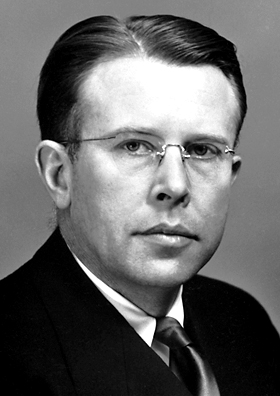Lawrencium
Lawrencium is a chemical element with the symbol Lr and atomic number 103. It is a synthetic element and is named after Ernest O. Lawrence, the inventor of the cyclotron, a device that was crucial to the discovery of many artificial radioactive elements. Lawrencium is the eleventh member of the actinide series in the periodic table.
Properties[edit | edit source]
Lawrencium is a radioactive element and has no stable isotopes. The most stable isotope, ^266Lr, has a half-life of about 11 hours. Due to its short half-life and the small amounts produced, the chemical properties of lawrencium have not been extensively characterized. However, it is expected to be a solid under normal conditions and is predicted to be a heavy metal that resembles other actinides.
Discovery[edit | edit source]
Lawrencium was first synthesized in 1961 by a team of researchers at the Lawrence Berkeley National Laboratory, led by Albert Ghiorso. The team produced lawrencium by bombarding californium with boron ions. The discovery was a significant achievement in the field of nuclear chemistry and added to the understanding of the synthesis of heavy elements.
Synthesis and Isotopes[edit | edit source]
The synthesis of lawrencium involves the use of a particle accelerator to bombard target atoms of heavier elements with ions of lighter elements. The most common method involves bombarding californium with boron. Several isotopes of lawrencium have been synthesized, with mass numbers ranging from 252 to 266. These isotopes are all radioactive and have short half-lives, making the study of lawrencium challenging.
Chemical Properties[edit | edit source]
Due to its radioactivity and the difficulty in producing lawrencium, its chemical properties are not well understood. However, it is expected to behave similarly to other actinides, with a +3 oxidation state being the most stable. Theoretical studies suggest that lawrencium may have some unique chemical properties due to the relativistic effects on its electrons.
Applications[edit | edit source]
Currently, lawrencium has no practical applications outside of scientific research due to its scarcity, radioactivity, and short half-life. The study of lawrencium and other transuranic elements is primarily of interest to scientists for advancing the understanding of the chemical and physical properties of heavy elements.
See Also[edit | edit source]
External Links[edit | edit source]
Given the constraints, this section is intentionally left blank.
![]()
This chemical element related article is a stub. You can help WikiMD by expanding it.
Navigation: Wellness - Encyclopedia - Health topics - Disease Index - Drugs - World Directory - Gray's Anatomy - Keto diet - Recipes
Search WikiMD
Ad.Tired of being Overweight? Try W8MD's physician weight loss program.
Semaglutide (Ozempic / Wegovy and Tirzepatide (Mounjaro) available.
Advertise on WikiMD
WikiMD is not a substitute for professional medical advice. See full disclaimer.
Credits:Most images are courtesy of Wikimedia commons, and templates Wikipedia, licensed under CC BY SA or similar.
Contributors: Prab R. Tumpati, MD




